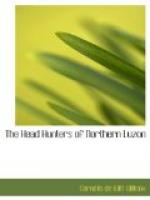that they must be punished if guilty of infringing
such laws and discipline as have so far been found
applicable. Accordingly, our guard-house held
two men, sentenced for twenty days, for having threatened
the life of one of their head men. Short as was
the sentence, these two men had nevertheless dug a
passage in the earthen floor of their quarters, and
had just the night before opened the outer end of it,
but not enough to admit the passage of a human body.
A private of Constabulary, passing by this morning,
stooped to examine this hole new to him, when one
of the prisoners threw a spear at him, made of a stalk
of
runo [25] the head being a small strip of
iron which he had kept concealed in his gee-string.
So true was his aim that, although he had to throw
his improvised spear between the rails, he nevertheless
struck the private in the neck, cutting his jugular
vein, so that in five minutes he was dead. The
pen was now entered for the purpose of shackling the
criminal, when he announced that he would kill any
white man that laid hands on him. Upon Lieutenant
Meimban of the Constabulary advancing, both of the
prisoners rushed him. In the mellay that followed
the murderer was shot and killed and his companion
badly beaten up; Strong later had to put seventeen
stitches in one scalp wound alone. Although the
rancheria from which the murdered private came
was two hours off, so that it usually took four hours
to send a message and get an answer, yet an hour and
a half after the man died a runner came in to ask
for his body so it could be suitably buried. Altogether,
this double killing damped our spirits considerably;
for one thing, there was no telling how it would be
received, particularly if there should be any excessive
drinking of
buhud; there were very few of us,
mostly unarmed, and the Ifugaos were coming in hundreds
at a time, so that long before the forenoon was well
under way several thousands had collected. However,
on moving out, we could not find that the cheerfulness
of the people had been in the least disturbed.
Before beginning the business of the day we walked
about the village and examined one or two houses.
These are all of one room, entered by a ladder drawn
up at night, and set up on stout posts seven or eight
feet high; the roof is thatched, and the walls, made
of wattle (suali), flare out from the base
determined by the tops of the posts. In cutting
the posts down to suitable size (say 10 inches in
diameter), a flange, or collar, is left near the top
to keep rats out; chicken-coops hang around, and formerly
human skulls, too, were set about. But the Ifugaos,
thanks to Gallman, as already said, have abandoned
head-hunting, and the skulls in hand, if kept at all,
are now hidden inside their owner’s houses, their
places being taken by carabao heads and horns.
One house had a tahibi, or rest-couch; only
rich people can own these, cut out as they are of a
single log, in longitudinal cross-section like an




